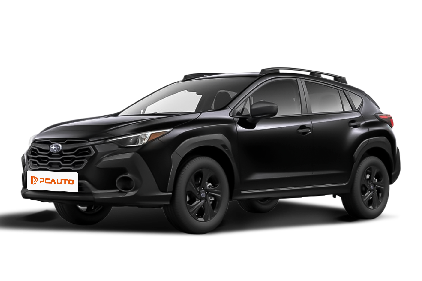Q
How to change the cabin air filter of Subaru Crosstrek?
Changing the cabin air filter in your Subaru Crosstrek is a straightforward DIY maintenance task that Malaysian owners can easily handle themselves. First things first, you'll need a new cabin air filter. It's best to go with an original equipment manufacturer (OEM) filter or a reputable third-party brand that meets the specs – this ensures proper filtration and a good fit.
In the Crosstrek, the cabin air filter is typically located behind the glove box on the passenger side. Open up the glove box, and you'll notice clips on either side. Give those a gentle press, and the glove box should fold down completely, revealing the filter cover. Pop that cover off, and there's your old filter. Keep an eye on the airflow direction arrow on the filter; make a mental note of which way it's facing so you can install the new one the same way.
Slide the new filter into place with the arrow pointing correctly, then just put the cover back on and close up the glove box. You're done! As a general rule, aim to replace the cabin air filter every 15,000 to 20,000 kilometers, or at least once a year. Malaysia's hot and humid climate means filters can quickly collect dust and mold. Regular replacements keep the air inside your car fresh and help your AC system last longer. If you often drive in dusty areas or industrial zones, you might want to shorten that interval.
If you're new to this, the first time around it's a good idea to check your vehicle's owner's manual or watch a few how-to videos from trusted sources. And if you run into any snags, don't hesitate to head to your nearest Subaru authorized service center for assistance.
Special Disclaimer: This content is published by users and does not represent the views or position of PCauto.
Related Q&A
Q
What is the resale value of a 2023 Crosstrek?
The resale value of a 2023 Subaru Crosstrek in Malaysia depends on several factors, including its condition, mileage, service history, and market demand. Generally speaking, this model holds its value pretty well in the used car market thanks to its reliable performance, full-time all-wheel drive system, and strong safety ratings. Low-mileage examples with a solid maintenance record typically retain around 60% to 70% of their original price, though actual figures will vary based on local market trends.
While Subaru remains a relatively niche brand in Malaysia, it boasts a dedicated following – especially among outdoor enthusiasts and off-road driving fans. This loyal customer base definitely helps support the Crosstrek's residual value. If you're planning to sell or buy a used Crosstrek, I'd recommend checking local classifieds platforms or consulting with professional valuers to get a more precise estimate. And remember, keeping up with regular servicing and maintaining complete repair records can significantly boost your vehicle's resale price down the line.
Q
Is the 2023 Crosstrek good in snow?
The 2023 Subaru Crosstrek really delivers when it comes to snowy conditions, and that's largely thanks to its standard Symmetrical All-Wheel Drive system. This setup automatically shuffles torque to the wheels with the most grip, and when paired with X-MODE (available on select trims), it further dials in traction for snow or slick surfaces. The 8.7-inch ground clearance also helps with getting through, making it solid for light snow cover. Now, Malaysia might not see snow, but that AWD tech still boosts stability on rainy, slippery roads. And if you're planning a winter road trip abroad, the Crosstrek's active torque vectoring and hill descent control will definitely have your back.
But here's the thing about snow performance—tires matter. The stock all-season rubber can struggle once the snow piles up, so swapping in winter tires or throwing on chains depending on your destination's climate is a smart move. For Malaysian drivers dealing with year-round heat, you're better off focusing on how the Crosstrek's EyeSight driver assist system handles heavy rain—features like automatic emergency braking and adaptive cruise control are way more practical day-to-day here.
Q
Where is the 2023 Crosstrek made?
The 2023 Subaru Crosstrek is primarily built at the company's Gunma plant in Japan, a facility renowned for its high manufacturing standards that ensure the vehicles meet global quality demands. For Malaysian buyers, this crossover will likely arrive via import channels. Its Japanese heritage means it carries over Subaru's signature boxer engine and Symmetrical AWD system – features that really shine in our local climate with frequent rain and those sometimes tricky road conditions we encounter.
A heads-up for potential owners: imported vehicles here often get tweaks for our tropical environment, things like upgraded cooling systems and more powerful air conditioning setups. Definitely worth checking those specifics with authorized dealers before signing on the dotted line.
Also, knowing where a car's made gives you a good idea of how it might hold up. Japanese-built models typically have solid reputations for durability and better resale value down the line. But keep in mind, import duties can affect the final sticker price, so that's something to factor into your budget.
Got more questions? Your best bet is to hit up Subaru Malaysia's official website or drop by your nearest dealership – they'll have the latest details to help you make the right call.
Q
What is the safest Subaru in 2023?
If you're after Subaru's safest ride in Malaysia for 2023, the Outback takes the crown. It's kitted out with the latest EyeSight Driver Assist Technology, packing features like adaptive cruise control, lane keep assist, and pre-collision braking. Then there's the high-tensile ring-shaped frame and a bunch of airbags working overtime. No surprise it aced those top safety picks from big names like ANCAP and IIHS.
Malaysian drivers will also appreciate Subaru's Symmetrical All-Wheel Drive – that thing really helps keep you planted when the monsoon hits and the roads turn slippery. Don't get me wrong, the XV and Forester are no slouches in the safety department either, but the Outback edges them out with its bigger body and that extra layer of safety gear.
A quick heads-up though: Malaysia's tropical heat can be tough on a car's electronics. Do yourself a favor and swing by an authorized service center regularly to make sure all those safety systems are ticking along nicely. And while Subaru's generous ground clearance is great for clambering over rough stuff, it does take a tiny bit of edge off the cornering stability. Just keep an eye on your speed when you're carving up those bends, that's all.
Q
Is the Subaru Crosstrek a good choice?
The Subaru Crosstrek is a compact SUV that fits the Malaysian market well. Its signature Symmetrical AWD system is a big plus for our rainy, wet roads – it really helps with grip during the monsoon season or when you're on those rural backroads. The 2.0L boxer engine strikes a nice balance between fuel economy and that low-center-of-gravity handling, making it equally at home in city traffic or for some light off-roading trips.
Inside, the Crosstrek comes standard with Subaru's EyeSight driver assistance suite, which includes adaptive cruise control and pre-collision braking. That's definitely a draw for safety-conscious families. One thing to note though, the rear legroom is a bit tighter compared to some rival Japanese models in its class.
Pitting it against popular choices here like the Honda HR-V or Mazda CX-30, the Crosstrek's trump cards are that standard AWD and a healthy 220mm of ground clearance. That makes it a solid pick if you occasionally need to tackle some unpaved paths, though it does mean you'll burn a tiny bit more fuel than a front-wheel-drive competitor.
Something to keep in mind: Subaru's dealer network in Malaysia isn't the most extensive. If you're considering one, it's wise to check where the service centers are located beforehand. If your budget stretches that far, the e-Boxer hybrid variant is worth a look – it'll give you better fuel efficiency around town. Just be aware that the battery pack does eat into some boot space, so you'll need to weigh that up.
Q
Where does the Subaru Crosstrek rank?
The Subaru Crosstrek has carved out a solid niche in the global compact SUV market, earning serious props for its top-notch safety and full-time all-wheel drive performance. Over in Malaysia, it's been turning heads too – drivers love its reliable handling and go-anywhere attitude that fits our local lifestyle. From what I've seen in international reviews, it consistently sits near the top of its class, especially when it comes to active safety tech and off-road capability. Perfect for Malaysia's rainy conditions and those occasional light off-road adventures we Malaysians love.
Digging a bit deeper, the Crosstrek's Symmetrical AWD system is a game-changer on slippery roads, keeping things stable when the monsoon hits. Then there's the EyeSight driver assist suite – it's like having an extra set of eyes on the road, which really adds peace of mind for daily drives. No wonder it's a hit with families and outdoor enthusiasts who prioritize practicality and safety.
In Malaysia, it's up against heavyweights like the Honda HR-V and Toyota Corolla Cross, but Subaru's got that unique brand appeal and technical edge that helps it stand out from the crowd.
Q
What is the battery problem in the Subaru Crosstrek 2023?
The 2023 Subaru Crosstrek has been reported to have battery-related issues in some markets, primarily manifesting as difficulty starting in cold weather or premature battery drain. This might be linked to the higher battery demands of the vehicle's start-stop system, and notably, Malaysia's year-round hot and humid climate could also accelerate battery aging. We advise owners to regularly check their battery's condition and ensure the terminals are clean and free of corrosion. If frequent starting problems occur, consider upgrading to a higher-spec AGM (Absorbent Glass Mat) battery for improved durability. It's important to note that modern cars come with more electronic devices (like 24/7 dashcams and connected car modules) that draw extra power. For those who mainly do short trips, we recommend driving for at least 30 minutes once a week to give the battery a full charge. For vehicles equipped with auto start-stop, if you're mostly driving in congested city traffic, you can temporarily disable this feature to reduce battery load. Also, avoid using the stereo or air conditioning for extended periods after the engine is turned off. If the problem persists, promptly contact an authorized service center for professional diagnosis, as abnormal battery behavior can sometimes indicate issues with the charging system or the need for a vehicle software update.
Q
What is the best selling Subaru model 2023?
As of 2023, Subaru's top-seller in Malaysia is the Subaru XV. This compact SUV has won over Malaysian buyers with its signature Symmetrical AWD system, generous ground clearance for solid go-anywhere ability, and the safety boost from EyeSight driver assist—perfect for the country's rainy weather and the mix of city and suburban roads. Under the hood, the 2.0-liter boxer engine strikes a nice balance between fuel efficiency and the agile handling that comes with a low center of gravity. The 2023 facelift stepped things up even more, packing an updated 8-inch infotainment screen and tweaked suspension that really sharpen its appeal.
It’s worth noting Subaru distributes through the Motor Image group here, and all models come with a 5-year unlimited mileage warranty—big plus for shoppers watching long-term ownership costs. Looking at other crowd-pleasers, the Forester pulls in families with its roomier cabin, while the Outback caters to niche buyers with its crossover wagon vibe. But the XV remains the brand’s sales backbone; its approachable price tag and just-right size make it a natural fit for Malaysia’s urban driving scene.
Q
What engine is in the 2023 Subaru Crosstrek?
The 2023 Subaru Crosstrek hits Malaysian shores with two boxer engine options: a 2.0-liter naturally aspirated four-cylinder (FB20) and a 2.5-liter naturally aspirated four-cylinder (FB25). The 2.0L puts out 154 horsepower and 196 Nm of torque, while the 2.5L steps things up to 182 hp and 239 Nm. Both mills come standard with Subaru's Symmetrical AWD system paired to a Lineartronic CVT gearbox.
What really sets this apart is that boxer engine layout – that low center of gravity does wonders for cornering stability, a signature Subaru tech trait. And let's not forget EyeSight driver assist comes standard across the range, giving that extra peace of mind on the road.
For Malaysian buyers, the Crosstrek's engine choices strike a solid balance between daily commuting fuel efficiency and light off-road capability. The 2.5L variant is especially worth considering if you regularly tackle mountain roads or just crave a bit more grunt when you put your foot down. Plus, having that full-time AWD as standard? It's a game-changer for those slippery wet season conditions, delivering way better traction than most in its class. All in all, this powertrain combo gives the Crosstrek some real technical edge in the crowded crossover segment.
Q
Why did Subaru discontinue Crosstrek?
Subaru's decision to discontinue the Crosstrek in select global markets is primarily a strategic move aimed at optimizing their product lineup and refining regional focus, not a reflection of any issues with the vehicle itself. Take Malaysia, for example – Subaru might be shifting gears to double down on models like the Forester or XV, SUVs that resonate more strongly with local buyers. These kinds of calls usually tie back to market demand, aligning with emissions regulations, or boosting production line efficiency.
Let’s be clear: the Crosstrek, as a crossover SUV, packs Subaru’s legendary Symmetrical AWD and Boxer engine tech – features that actually make a ton of sense for Southeast Asia’s rainy and often tricky terrain. But automakers constantly tweak their offerings based on local sales figures, the costs of adapting to right-hand-drive markets, or how quickly they’re pivoting to new energy vehicles.
If Malaysian shoppers are jonesing for something similar, keep an eye on the Subaru XV. It shares the Crosstrek’s core platform and tech but gets a cooling system dialed in for tropical climates. Plus, with local CKD (completely knocked down) assembly, it might just come with a more wallet-friendly price tag. And let’s not forget – these discontinuation moves often clear the path for new generations. Down the line, Subaru could very well revive the Crosstrek nameplate with hybrid power or a full EV setup.
Popular Cars
Model Year
Car Compare
Car Photo
Latest Q&A
Q
How much does it cost to buy a 2024 Tesla Model 3?
The 2024 Tesla Model 3 starts at around RM 175,000, but the final price depends on your chosen configuration and add-ons. Opt for the Long Range or Performance version, and you’re looking at a higher tag.
As Tesla’s entry-level model, it packs cutting-edge EV tech, including 500+ km of range on a single charge and standard Autopilot for both daily commutes and road trips. Just keep in mind extra costs like insurance, registration, and potential home charger installation.
Tesla’s Supercharger network is expanding locally, with solid coverage in major cities, making charging hassle-free. Maintenance costs? Typically lower than gas cars—no oil changes, fewer moving parts—so long-term savings add up.
If you’re after more thrills, the Performance variant hits 0-100 km/h in roughly 3 seconds. Plus, government EV tax perks help soften the upfront cost.
Q
How reliable is the 2024 Model 3?
The 2024 Model 3 delivers solid reliability, thanks to Tesla’s continuous software updates and hardware refinements. Key areas like the battery management system and Autopilot have seen multiple optimizations, leading to a noticeable drop in failure rates.
This model features a stiffer body structure and an improved suspension setup, offering a smoother ride. Upgraded interior materials also help reduce cabin rattles—a common gripe with earlier builds.
EV maintenance costs remain low (no oil changes, etc.), though it’s wise to periodically check battery health and charging components for long-term performance. For shoppers eyeing EVs, charging infrastructure and home charging options matter—thankfully, public chargers are expanding fast, making daily use more convenient.
If you frequently road-trip, planning charging stops ahead helps. While the range easily handles daily drives, a little route prep goes a long way in maximizing the experience.
Q
What is the battery range of the Tesla Model 3 2025?
The battery range of Tesla Model 3 2025 is expected to be optimized based on existing models, and specific data needs to be released officially. However, referring to the EPA range of the 2024 rear wheel drive version, which is about 438 kilometers, and the high-performance version, which is about 513 kilometers, the 2025 model may further improve, especially in terms of battery technology or energy efficiency management. For electric vehicles, the range is greatly affected by driving habits, road conditions, and climate. Air conditioning may slightly reduce the range in hot weather, but the battery thermal management system can usually maintain stable performance. In terms of charging, Model 3 supports super fast charging, which can replenish about 250 kilometers of range in about 15 minutes, while home charging stations require 6-8 hours to fully charge. Daily commuting or long-distance travel are practical enough, it is recommended to follow Tesla's official website or local showroom for the latest information.
Q
Is the 2024 Model 3 worth the price?
The 2024 Model 3 strikes an impressive balance between price and performance. Its upgraded range, more refined interior, and enhanced autonomous driving features genuinely boost its competitiveness—especially for tech-savvy, eco-conscious buyers.
Tesla optimized the battery efficiency this time around, making it suitable for both daily commutes and longer trips, while the handling stays true to the brand’s signature responsiveness. If your budget allows and you’re open to EVs, this one’s worth considering—though a test drive is wise to see if it matches your driving style.
That said, local charging access matters. While public chargers are becoming more common, home installation costs should factor into your budget. Alternatives in this price range exist, so cross-shop specs and service policies (like warranty coverage or charging network support) to make a well-rounded decision.
Q
How many miles does a 2024 Tesla Model 3 get?
The 2024 Tesla Model 3 offers varying range figures depending on configuration. The rear-wheel-drive (RWD) version delivers an EPA-estimated 272 miles (approx. 438 km), while the all-wheel-drive Long Range model pushes that to around 341 miles (roughly 549 km). Real-world range may vary slightly based on driving style, road conditions, and climate.
As a pure EV, the Model 3 achieves this efficiency thanks to its advanced battery management system and lightweight design. It also supports fast charging—at a Tesla Supercharger, you can add up to 200 km of range in about 15 minutes. Whether for daily commutes or longer trips, that’s more than enough for most drivers, especially with charging infrastructure becoming more widespread.
If you need to maximize range, tweaking your driving mode or using the car’s built-in energy optimization features can help squeeze out even more miles.
View MoreRelated News

Brand new hybrid system, range over 1000km! New model Subaru Crosstrek coming in December!
RobertOct 22, 2024

Subaru Registers New EV Trademark, Signaling Strategic Shift
Kevin WongAug 8, 2025

Uncharted is Subaru's first front-wheel-drive car, with a range of up to 482 kilometers.
MichaelJul 18, 2025

SUBARU REX Hybrid vs Nissan e-POWER: Spot the Difference!
WilliamJun 24, 2025

All-New Subaru Outback Debuts with SUV-Inspired Styling
JohnApr 22, 2025
View More


















Pros
Cons